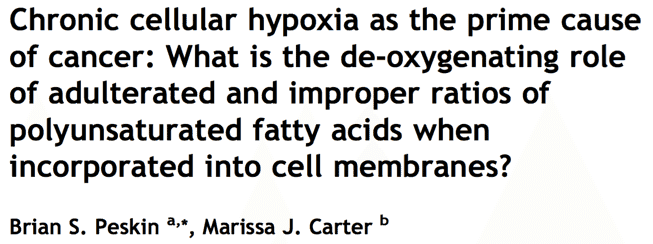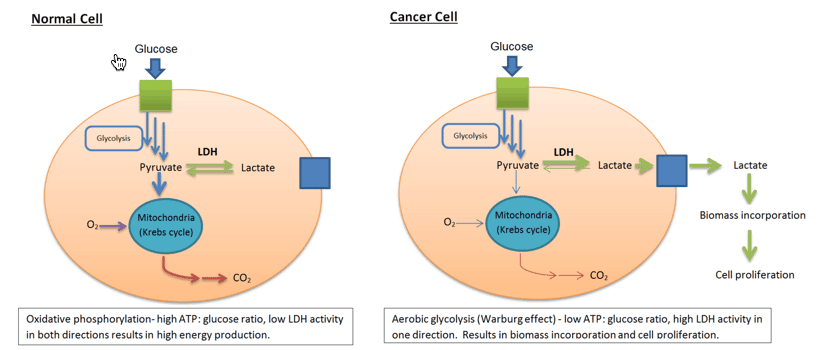
Until they sold out, the journal Medical Hypotheses contained some of the most fascinating health and medical ideas.
When I say they sold out, I mean that they caved in and formed a peer review committee to review all articles that must pass muster before being published.
This has killed the originality of the journal that made it so interesting.
Now, only ideas that don’t conflict with the established medical viewpoints are going to be published.
Oh well.
Today’s newsletter is bulit around a paper in Medical Hypotheses that was already published the “old way,” and it’s amazing.
 It’s all about what causes cancer.
It’s all about what causes cancer.
There are two major theories about what causes cancer.
Theory number one is the mutation theory.
This is pretty much what all doctors and many researchers believe today is the cause of cancer.
The theory is that the mutations create these monster rogue cells that are much faster in replication and better at taking over the body’s resources.
They spread quickly through metastasizing, which is a phenomenon where they’re supposed to splinter off, flow from the tumor into other parts the body, and colonize those parts of the body as newly formed cancers.
The other belief about what causes cancer, is the metabolic theory.
The metabolic theory says the cancer is caused by poor metabolism.
Poor metabolism creates cancerous cells, and then these cancer cells grow under the conditions of continued poor metabolism.
I think there’s a lot of evidence for cancer being a metabolic disease.
Perhaps the granddaddy the theory of cancer as a metabolic disease is Dr. Otto Warburg.
The Nobel Prize winner Dr. Warburg discovered that cancer cells are always hypoxic, meaning they are low in oxygen.
 Once a cell is low in oxygen for a long enough, it will make certain adaptations to the low oxygen environment.
Once a cell is low in oxygen for a long enough, it will make certain adaptations to the low oxygen environment.
The cell creates energy through something called aerobic glycolysis.
Glycolysis is the process that cells use to metabolize glucose into energy, and there are two forms.
Anaerobic Glycolysis is the process that our bodies use primarily, and it means that the glucose in broken down in the without the use of oxygen.
Aerobic glycolysis is when the glucose is broken down using the reaction between hydrogen and oxygen.
All cancer cells seem to do a lot of aerobic glycolysis.
This is not a healthy form of creating energy.
It’s a metabolically deficient way of creating energy, but it works in an environment with low oxygen.
Dr. Warburg discovered that aerobic glycolysis is the chief way to distinguish cancer cells from other cells.
All cells have the ability to create energy using aerobic glycolysis if necessary.
But cancer cells do it all the time.
Normal cells only do it during periods of high stress such as vigorous exercise.
The authors of the paper say that:
Warburg showed that cancer could always be initiated with a decrease in cellular oxygen… that a 35% inhibition of oxygen respiration was sufficient to bring about transformation of a normal cell to a cancerous cell.
This has been validated by other researchers since Dr. Warburg.
But now, the authors of this paper ask
why cancerous cells cannot revert back to a precancerous state if given enough oxygen?
Because Dr. Warburg and other researchers found that once a cell is cancerous, it never goes back to being noncancerous.
But healthy cells go back and forth as they need to between anaerobic and aerobic metabolism.
So now the authors of this paper suggest that cancer could be caused by polyunsaturated fatty acids.
They describe how today’s diet is very high in omega-6 PUFAs — such as cottonseed oil, soy oil, Cornwell, etc.
These PUFAs get incorporated into the cell where they oxidize and form huge swarms of free radicals that cause the cells to become hypoxic and then become cancerous.
So why is that? How do the authors propose PUFAs cause cancer?
For many years, PUFAs have been known to incorporate in both cell and the inner mitochondrial membranes responsible for cellular respiration.
Okay, so now were getting somewhere.
These very unstable PUFAs are incorporated in the cell membranes, and in the cell mitochondria.
It’s a little like putting crazy people in charge of security at a rave.
The crazy people are unstable and will create disturbances.
So will the PUFAs in the cell and mitochondria membranes.
The authors speculate that contaminated, rancid or poor-quality PUFAS
are incorporated into cell membranes and interfere with the oxygen transmission into cells required for respiration.
Which then triggers the so-called Warburg Effect, creating cancer.
I think there are a lot of flaws this hypothesis.
I think it’s quite half-baked, and completely inaccurate in most ways.
However, I think that the idea that
- highly unstable PUFAs get incorporated into the cell membranes and mitochondria, and
- therefore, trigger a cascade of reactions that result in cell oxygen levels becoming dangerously low,
- and therefore, through the Warburg Effect, becomeing cancerous
may very well be at least partially correct.
The authors of this paper claim that PUFAs are good and necessary, it’s just that bad PUFAs are a reason for cancer.
I think it’s all PUFAs.
But that’s another study and another day.
Meanwhile, I would definitely cut out vegetable oil, fish oil, and any kind of fatty or fried foods except for good healthy butter, coconut oil, and Olive Oil.
It does seem that minimizing fat, especially PUFAs, increases lifespan and lowers obesity.
Citations
Chronic cellular hypoxia as the prime cause of cancer: what is the de-oxygenating role of adulterated and improper ratios of polyunsaturated fatty acids when incorporated into cell membranes?
http://www.medical-hypotheses.com/article/S0306-9877(07)00388-X/abstract
Click for more information on Cause of cancer, for information on Living Healthy.
